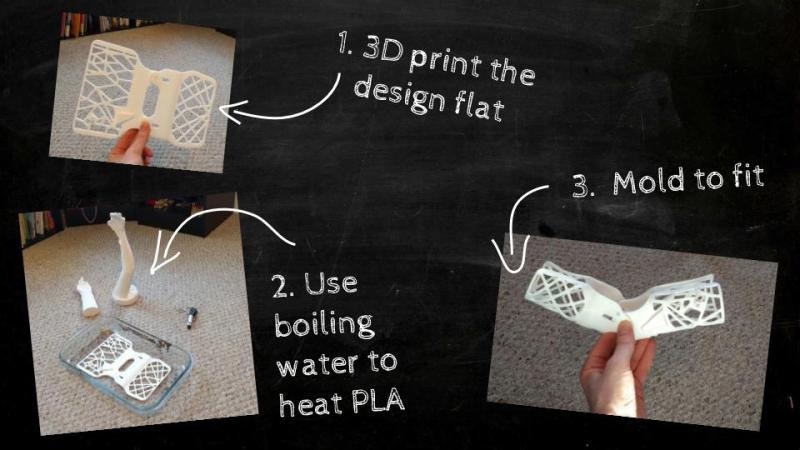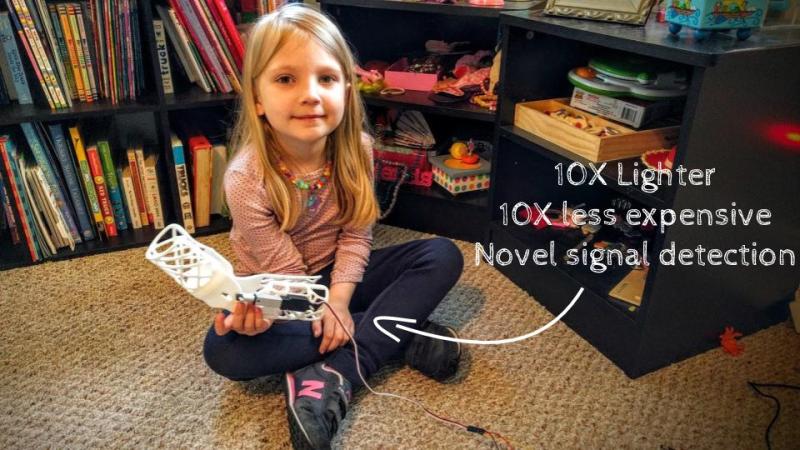Bodo Hoenen and his family had an incredible scare. His daughter, Lorelei, suddenly became ill and quickly went from a happy and healthy girl to one fighting just to breathe and unable to move her own body. The culprit was elevated brain and spinal pressure due to a condition called AFM. This is a rare polio-like condition which is very serious, often fatal. Fortunately, Lorelei is doing much better. But this health crisis resulted in nearly complete paralysis of her left upper arm.
Taking an active role in the health of your child is instinctual with parents. Bodo’s family worked with health professionals to develop therapies to help rehabilitate Lorelei’s arm. But researching the problem showed that success in this area is very rare. So like any good hacker he set out to see if they could go beyond the traditional to build something to increase Lorelei’s odds.
What resulted is a wearable prosthesis which assists elbow movement by detecting the weak signals from her bicep and tricep to control an actuator which moves her arm. Help came in from all over the world during the prototyping process and the project, which was the topic of Bodo Hoenen’s talk at the Hackaday SuperConference, is still ongoing. Check that out below and the join us after the break for more details.
The core concept is to provide assistive feedback which will help Loreli’s body get better at relearning how to command her affected bicep and tricep.
Challenges
There’s a hard limit on weight for this project. That’s because too much weigh on the shoulder and it can be pulled out of the socket due to the current weakness. Hopefully this will also improve with time, but for now the assistive device needs to weigh less than 150 grams.
The actuator must be able to move the mass of her forearm (about 400 g). Input should come from the bicep and tricep using electromyography. They also want a relatively long battery life of at least five hours, and for the final product to look nice, lest she not want to wear it.
No Prior Experience
How do you build something with no prior experience? For regular Hackaday readers that’s not a real question… we do it all the time. Bodo didn’t have experience with most of what went into this project, but cites his entrepreneurial experiences in tackling hard problems. The trick is to learn what it is you don’t know and then ask for help in those areas when needed.
What we really like is that he didn’t just build this for her but built it along with her. The two of them started researching what kind of things other people had built: how people were taking muscle signals and using them to move things. They came up with some ideas, when hitting road blocks they asked for help and the world responded.
 They received help in learning how to 3D scan Lorelei’s arm for the best fit. A company in Canada sent them some actuators that met their weight, size, and power constraints. When they tested out the EMG sensors they discovered the signals on her damaged arm were almost completely lost in the noise. Again, help came in from a company working on a very similar problem. A new seventeen-sensor method was adopted that uses machine learning to find those signals. Most recently they have turned this into a video game — Lorelei is retraining her body by moving an arm onscreen. Gamification of physical rehab? Yes please!
They received help in learning how to 3D scan Lorelei’s arm for the best fit. A company in Canada sent them some actuators that met their weight, size, and power constraints. When they tested out the EMG sensors they discovered the signals on her damaged arm were almost completely lost in the noise. Again, help came in from a company working on a very similar problem. A new seventeen-sensor method was adopted that uses machine learning to find those signals. Most recently they have turned this into a video game — Lorelei is retraining her body by moving an arm onscreen. Gamification of physical rehab? Yes please!
The physical prototype is moving right along. It was first assembled with Fischer Technik. With that proof in hand they 3D printed a lattice out of PLA. This was designed from the 3D scan of her arm, printed flat, then submerged in boiling water to soften it before being molded to a full-sized cast of her arm. The result is visually pleasing, light weight, sturdy, and well-fit to her arm.
It is very rare that children who have loss of muscle control from this condition are able to gain it back. But some progress has already been made. We think it’s amazing to see an outpouring of goodwill to help Bodo and his daughter in this endeavor and it has far-reaching benefits. She is learning a lot about engineering and what is possible in life. And they have built an example for others to follow when they are met with obstacles they need to overcome.
















What a great idea of softening PLA prints to be molded around complex geometries!
I couldn’t agree more! I’ve been printing with PLA for over a year, and never once thought to use what I would have said was PLA’s biggest weakness, as a strength!
Kudo’s for you and your family taking this chair head on. Why don’t you move the actuator away from the arm like with bicycle handbrakes. That might lessen the weight. Also try to hang external gear, battery, CPU, etc. On her hips. When hiking it might look like everything is on your shoulders but the main weight bearing part is the hip band. The hips are made for bearing weight, the back is not. I the back is already holding the head and upper body.
Good luck to all of you!
Good suggestion, we came up with the same approach. The battery, sensor boards and controller are all kept in Lorelei’s pocket. The actuator is just 70g and therefore we are keeping well below our 150g target.
As heart warming and awesome this is(and it is! For sure!), I worry about side effects to any home made prosthetic. I could list a dozen things off the top of my head, but I sure you can imagine most of them.
One of the rules doctors have is to not treat loved ones. It’s there for good reason. I think you could extend that to amateur doctors not treating they loved ones as well. Just my 2 cents – I’m sure people will disagree with me.
Yep. I disagree, perhaps if you have an option than get some one else’s to do the dirty work, doctors are a dime a dozen if you want someone to write sick certificate or tell you take two aspirin and see me in the morning.
But if you want some serious research done or custom solution than you need to do it yourself or own a gold mine.
No one cares more about your child than you do.
And if no one else can treat your child, than you do.
+1
Wonderful. I love the time I am living in.
All my best wishes go to Lorelei, Bodo and the rest of the family!
Thank you so much for the support and taking the time to write this message!
Hello are you all making any more strides with this prosthetic because I am curious to know if this will work on an adult with arm paralysis